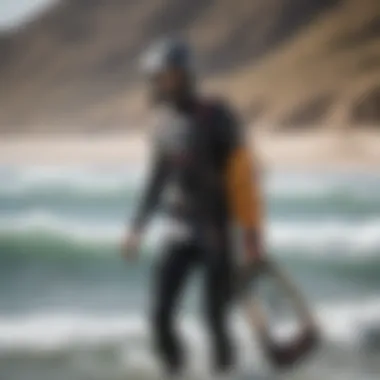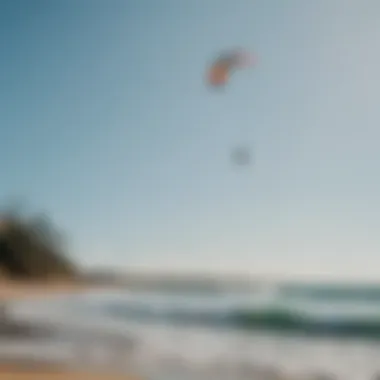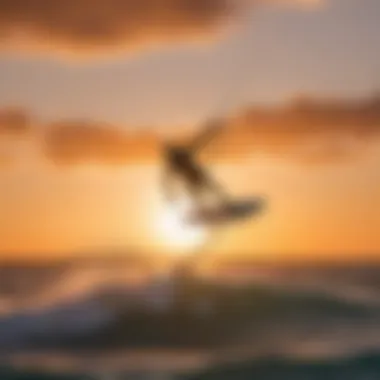Mastering Kite Surfing in Northern Waters: A Guide


Intro
Kite surfing in northern regions can be a thrilling yet challenging endeavor, and it’s not just a walk in the park. High winds and cooler temperatures create a distinct environment that kiteboarders need to navigate carefully. For both the rookie looking to find their footing and the seasoned rider wanting to push their limits, understanding these unique conditions is key. You want to make sure you have the right gear, grasp essential techniques, and know the best spots to ride.
The northern locales offer breathtaking landscapes, fresh breezes, and vast open waters, but they also come with their own set of challenges—making preparation a priority. This article seeks to unravel all the necessities, from the nitty-gritty details of gear selection to advanced tricks, ensuring that readers walk away with a clearer picture of kite surfing in these regions. Let’s buckle up and take a deep dive into what makes this sport both fascinating and rewarding.
Foreword to Kite Surfing in Northern Regions
Kite surfing in the northern regions presents a unique blend of exhilarating experiences and vast landscapes. Unlike any other, this sport thrives where the wind meets the water, giving thrill-seekers the chance to glide across stunning aquatic vistas. For enthusiasts, understanding the nuances of kite surfing in these locales can significantly elevate their overall experience.
Definition and Essence of Kite Surfing
Kite surfing, at its core, consists of riding on a board while being pulled by a large, controlled kite. The kite works like a sail, taking advantage of wind power to propel the rider across the surface of the water. To a newcomer, this might sound daunting; however, the essence of kite surfing lies in the harmony between the rider and nature. It’s not merely about speed or tricks; it’s about syncing with the wind, feeling the rhythm of the waves, and embracing the pure joy of riding.
Kite surfing encompasses a variety of styles and techniques which cater to different skill levels and preferences. From freestyle moves to wave riding, each facet offers something distinct, contributing to the sport's growing popularity. The feeling of soaring over water, aligned with the wind's embrace, creates a sense of freedom that attracts people from all walks of life.
The Appeal of Northern Kite Surfing
Northern kite surfing stands out due to its spectacular environments and diverse conditions. Picture vast lakes or the open sea stretching under a seemingly infinite sky, punctuated by gusty winds that entice surfers to take to the water. In these regions, the scenery itself is a major draw, combining natural beauty with the thrill of the sport.
Advantages of kite surfing in northern locations include:
- Unique Weather Patterns: The winds in these areas can be both stable and powerful, providing excellent conditions for both learners and experts.
- Lesser Crowds: While southern beaches can be bustling, northern spots often offer more solitude. This means more room to practice and less interference from other water users.
- Seasonal Variety: Kite surfing can be enjoyed across diverse seasons. Whether it's winter with ice and snow or the lure of summer’s warm wind, each season has its charm.
- Community and Culture: Many northern regions have a vibrant kite surfing community. Engaging with experienced locals can lead to invaluable insights, tips, and camaraderie that enriches the overall experience.
"Every time I hit the water in the north, it’s as if the world fades away. It’s just me, the kite, and the elements. Pure magic!"
Northern kite surfing isn't simply a sport; it's a gateway to adventure and exploration in some of the most breathtaking landscapes one can imagine. Understanding it not only enhances your skills but also deepens your appreciation for the various elements that come into play. As we move forward into this guide, we will delve into the specific conditions, gear, and techniques, painting a fuller picture of what it means to kite surf in the north.
Understanding Wind and Water Conditions
Kite surfing thrives on more than just a board and a kite. The interplay of wind and water is fundamental to anyone looking to ride the northern waves successfully. Knowing how to read and respond to different wind patterns and water conditions can mean the difference between a thrilling experience and a harrowing one. Climate factors and seasonal shifts invite both challenges and opportunities, making this knowledge essential for enthusiasts of all levels.
Analyzing Wind Patterns
Wind is the lifeblood of kite surfing. Understanding how to analyze wind patterns can significantly influence a surfer's performance. Northern regions often present a unique set of variables that can affect wind strength and direction.
- Onshore Winds: These help create gentle and consistent conditions. Surfers can enjoy longer sessions with safer returns to shore.
- Offshore Winds: While sometimes thrilling, they can lead to dangerous situations where getting back to land becomes a chore.
- Cross-shore Winds: These winds carry the surfer parallel to the shore, often providing an exhilarating ride but requiring more skill to navigate effectively.
Spotting these patterns can empower kite surfers to choose the right time and place to catch the wind just right. Beyond just strength, understanding the gusts—those sudden shifts in wind—can also enhance safety and performance.
"Understanding wind is like reading a map for kite surfers; without it, one can easily stray far from the shore and safety."
Water Conditions: Lakes vs. Oceans
The choice between lakes and oceans can heavily influence the kite surfing experience. Each has distinctive characteristics that cater to different preferences.
- Lakes: Generally flatter, lakes offer a more forgiving environment, especially for beginners. The lack of waves and smaller swells can promote faster learning curves. Moreover, local weather patterns often produce more consistent wind.
- Oceans: The vast expanses bring the excitement of larger waves and swells, appealing to more experienced surfers. However, they also introduce unpredictability with strong currents and changing tides. Those who adventure into ocean waters should be well-versed in tide patterns and how they interact with wind conditions.
When deciding where to surf, consider your skill level and the kind of challenge you're looking for. Both venues can offer extraordinary experiences but come with their own set of challenges.
Seasonal Variations Affecting Kite Surfing
The northern climate changes dramatically with the seasons, creating varied kite surfing conditions. These shifts require surfers to adapt constantly and understand how each season can affect their activity.
- SprinG: Often brings brisk winds and can lead to exciting, unpredictable conditions. Surfers must remain alert to sudden changes in weather as spring storms can roll through.
- Summer: Typically marks peak kite surfing season, with more stable winds and warmer temperatures. However, it can also attract more crowds, modifying the experience.
- AutumN: Offers great wind conditions as summer ends, but water temperatures can drop rapidly, requiring proper gear.
- Winter: Can provide dramatic conditions but also brings challenges, such as ice on lakes or extreme cold. Only the seasoned should hit the water in these colder months.
Every season has its story. Tailoring your approach to each can help you not only stay safe but also enhance your skills while kite surfing in the northern hemisphere.


Essential Gear for Northern Kite Surfing
Kite surfing, especially in northern locations, relies heavily on having the right gear. This isn’t just about style or brand image; your equipment can make or break your experience on the water. In the northern regions, unpredictable weather and varying water conditions demand specialized gear to ensure both performance and safety. Here, we delve into the crucial components of kite surfing gear, providing insight into what kiteboarders need to thrive in these challenging environments.
Kite Selection: Types and Sizes
When it comes to kites, the variety available can feel as vast as the ocean itself. The two central categories of kites are C-kites and bow kites. C-kites offer responsive handling, making them favored for tricks and freestyle. Conversely, bow kites are known for their stability, giving riders a smoother experience in gusty winds, which can be common in the north.
Size matters in kite selection. A larger kite catches more wind, which translates into greater lift and speed but also requires more experience to manipulate effectively. For light wind conditions typical in northern waters, a size range between 12m to 14m is often recommended. If the winds are stronger, a 7m to 10m kite may serve better. However, gauging local wind patterns is crucial; incorrect sizing can lead to difficult riding or even accidents.
Board Choices for Varied Conditions
The choice of board significantly affects your kite surfing experience. If you find yourself in flat water, a directional board might serve well. These boards allow for straight travel on the water, ideal for those who enjoy cruising or long-distance rides. Alternatively, twin-tip boards provide versatility, enabling riders to switch directions effortlessly.
For northern regions, the board size plays an essential role as well. A larger board gives more surface area when dealing with lighter winds, while a smaller board is better suited for strong winds and wave riding. Many board designs also consider the conditions typical to the region (like choppy water or waves), so making the right choice here can enhance your grip, speed, and overall enjoyment.
Safety Equipment: Must-Have Items
Kite surfing can be thrilling, but it comes with its own set of risks. That's why safety equipment should never be an afterthought. At the very least, every kiteboarder should invest in the following essentials:
- Harness: Keeps you attached to the kite without straining your body. Full harnesses are generally more comfortable and provide better support than waist harnesses.
- Impact vest: Not just for serious falls, but also to protect against the chilly water temperatures of northern regions.
- Helmet: A must for avoiding head injuries, particularly in busy spots or during jumps. Always opt for options designed for water sports.
- Safety leash: This device ensures your kite observes control even if you're separated from it.
“The best safety measure is knowledge; understanding your gear and surroundings will keep you one step ahead of any potential hazards.”
Having this safety equipment is essential, but it’s not everything. Ensure you regularly check and maintain your gear. Keep an eye on wear and tear, booking periodic professional inspections if necessary. This proactive approach can extend the life of your gear and contribute to your safety during kite surfing excursions.
In summary, whether it’s selecting the right kite, choosing the appropriate board, or ensuring you have the necessary safety gear, each element plays a vital role in enhancing your kite surfing adventure in northern waters. Being equipped not just with the right gear but also with understanding how to use it will help you navigate through the exhilarating challenges that kite surfing presents.
Techniques for Northern Kite Surfing
Kite surfing isn't just about flying a kite and riding on water; it's an intricate dance between the elements, the gear, and the rider. Developing solid techniques for kite surfing in the northern regions is paramount for maximizing your enjoyment and safety while on the water. Given the unique environmental variables found in the North—like changing winds and diverse water conditions—mastering these techniques becomes not just beneficial, but essential.
Fundamentals of Kite Control
Understanding the core principles of kite control can be the difference between a thrilling experience and a harrowing one. Two primary elements comprise the art of kite control: steering and power management.
- Steering Your Kite
- Power Control
- The kite's position significantly influences your speed and direction. Learning to steer effectively involves grasping the nuances of the wind window, which is where the kite operates most efficiently.
- Practice zipping your kite back and forth across the wind window. Engaging the back lines will pull your kite down, while the front lines help steer it up.
- Building power involves finding the right balance. Too much power can lead to loss of control, while too little can leave the rider stranded. Adjusting the kite's angle relative to the wind is crucial here.
- Use your body to absorb power; lean back as the kite pulls. This will help stabilize your ride and improve your control.
Expert Tips for Jumping and Tricks
Once you've got kite control down, it’s time to unleash some aerial maneuvers. Mastering jumps and tricks not only elevates your skills but also adds a level of excitement to your sessions. Here are a couple of valuable insights:
- Timing is Key: Initiate your jump as the kite reaches the zenith of its lift. This allows you to harness the kite's power effectively.
- Board Positioning: Keep your knees slightly bent and your board level. Try to use your heels to push down; it helps in launching upwards more seamlessly.
"Success in jumping relies not solely on the kite’s pull but also on your understanding of when to commit to the leap."
- Use Your Arms Wisely: When lifting off, a quick pull on the back hand will send your kite higher, increasing the jump height.
Navigating Challenging Conditions
Northern kite surfing often ushers in unpredictable weather patterns that can complicate your ride. Here are some strategies to effectively navigate these hurdles:
- Monitor Weather Patterns: Always keep an eye on local forecasts. Wind directions change and can catch any unprepared rider off guard. Apps and websites like Windy or KiteFinder can be invaluable.
- Assess Water Conditions: Lakes can generate different fluctuations compared to ocean currents. For instance, understanding how waves and swells interact with wind can provide insights into what to expect.
- Safety First: Prioritize safety gear, especially when conditions seem sketchy. Wearing a helmet and impact vest offers added protection against unexpected falls.
Mastering these techniques will enhance your kite surfing experience in northern regions. As every surfer knows, the relationship with nature, gear, and skills develops over time. So, practice regularly, stay aware of the conditions, and soon you'll find yourself riding high above the water with confidence.


Notable Locations for Kite Surfing in the North
Kite surfing offers exhilarating experiences, and the northern regions boast unique conditions that can enhance or challenge this sport. Identifying notable locations not only helps enthusiasts maximize their potential on the water, but it also fosters a sense of community among kite surfers. Northern spots provide a unique blend of wind patterns, water characteristics, and natural beauty, creating an ideal canvas for kiteboarding and adventure. Understanding the specific elements of these locations is crucial for kiteboarders of all skill levels.
Top Kiteboarding Destinations
When discussing kiteboarding hotspots in the northern territories, a few names invariably rise to the surface, well-known for their wind reliability and stunning scenery. Locations such as Hatteras Island, North Carolina, and Cape Cod, Massachusetts stand out as premier destinations. Hatteras Island, with its warm climate and flat waters, draws both novices and veterans alike. The combination of consistent wind patterns and idyllic surroundings makes it a kiteboarder’s paradise.
Cape Cod offers a different vibe with coastal landscapes where riders can navigate both ocean waves and flat-water conditions. Not only do these regions cater to the thrill-seekers, but they also provide amenities and services that make for a seamless kiteboarding experience.
Other prominent spots include:
- Maui, Hawaii – revered for its stunning beaches and strong trade winds, despite not being strictly northern, it’s frequently sought by kite surfers during winter months.
- Lake Ontario, Canada – here, freshwater conditions are a draw, with scenic views that captivate riders.
- Tarifa, Spain – recognized as the wind capital of Europe, known for its breezy conditions.
These destinations not only support optimal kiteboarding, they also enhance the overall kite surfing experience through community-focused events and local tournaments.
Hidden Gems: Lesser-Known Spots
Beyond the well-trodden paths of kite surfing, lesser-known locations are beginning to capture the attention of the kiteboarding community. These spots often provide a more intimate and less crowded environment for enthusiasts.
Consider Scotland's Outer Hebrides. While not the first location to come to mind for many, its remote beaches and consistent winds surprise those who make the trek. Here, you can experience kite surfing amongst stunning landscapes, making every session unforgettable.
Another hidden gem is Lake Windermere, nestled in the Lake District of England. This location might be overlooked, yet the combination of its beautiful settings and relatively calm waters can be perfect for those practicing new tricks or leisurely cruising.
Exploring these lesser-known spots can result in a fulfilling experience, often rewarding those who seek adventure beyond the mainstream.
Factors to Consider When Choosing a Location
Selecting the right spot for kite surfing involves more than just searching for the wind and water conditions. Here are some key elements to consider:
- Wind Patterns: Knowing the prevalent local winds helps you gauge the best times to kite surf. For instance, predictable offshore winds can create optimal conditions, whereas turbulent winds may require more advanced skill sets.
- Water Conditions: Distinguishing between ocean waves and flat lakes is vital. The choice of water body directly influences performance, with flat waters generally being more favored by beginners.
- Local Regulations: Always be mindful of local restrictions around kite surfing. Certain areas might have zones where kite surfing is prohibited or has specific rules in place.
- Weather Patterns: Understanding the local climate, including seasonal changes, helps in planning trips effectively. Misjudging the weather can lead to unfavorable conditions, turning a much-anticipated day into a challenging experience.
- Accessibility: Evaluate how easy it is to reach the location, along with the availability of facilities and amenities necessary for a pleasant day on the water.
"Choosing the right location can be the difference between a thrilling adventure and a frustrating outing. Know before you go, and let the winds and waters dictate your experience."
In summary, the northern regions hold vast potential for kite surfing enthusiasts. By exploring both well-known and hidden locales, kite surfers can enrich their experience in this exciting sport.
Safety Considerations for Kite Surfing
When kite surfing in northern regions, safety isn't just a good idea; it's essential. The sport, exhilarating as it is, does carry inherent risks. Therefore, understanding safety considerations becomes paramount for both beginners and seasoned surfers. This section will shine a light on several integral elements, benefits, and crucial points about kite surfing safety.
Understanding Risks and Hazards
Kite surfing can be an unpredictable sport, especially in the northern territories where conditions can change in the blink of an eye. Wind strength and direction, water temperatures, and even the presence of obstacles all present various risks. Some common hazards include:
- Strong currents and tidal changes: These factors can lead to difficult returns to shore.
- Obstacle dangers: Rocks, jetties, and shallow waters can pose significant threats.
- Wind variability: Sudden gusts can catch even the most experienced kite surfer off guard.
Being aware of these risks ensures that surfers prepare adequately, enabling them to make informed decisions on when and where to kite surf.
"Preparation is key. Know your environment before you venture out."
Basic First Aid for Kite Surfers
Accidents can happen, from minor scrapes to more serious injuries, so knowing a pinch of first aid can come in handy. Here are some basic first aid tips suitable for kite surfers:
- Cuts and scrapes: Always carry waterproof bandages and antiseptic wipes to clean cuts before covering them.
- Sprains or strains: Using ice packs can reduce swelling. Keeping a compression bandage handy could also be beneficial.
- Hypothermia: If water temps are low, even a short exposure might require warming measures—dry clothes and warm drinks can help.
Having a basic first aid kit tailored for kite surfing can make a huge difference in how one responds to common injuries.


Emergency Protocols and Procedures
Despite our best efforts, emergencies sometimes arise. Having a plan is as crucial as practicing kite surfing itself. Here’s a straightforward breakdown of effective emergency protocols:
- Communication: Keep a mobile phone or a two-way radio accessible for quick communication. Sharing your location with someone before heading out is also wise.
- Establish a buddy system: Surfing with a partner increases safety. They can assist during emergencies and also help keep an eye on each other.
- Know your escape routes: Before starting, familiarize yourself with nearby safe areas in case conditions worsen.
In the face of emergencies, remaining calm and executing pre-planned procedures can mean the difference between a mishap and a catastrophic situation.
The Community and Culture of Northern Kite Surfing
Kite surfing in northern regions isn’t just about the wind and waves; it’s deeply woven into a vibrant community and culture that enriches the sport. The bonds formed among kite surfers transcend geographical borders, creating a sense of belonging amongst participants of all skill levels. This camaraderie is built on shared experiences, challenges, and mutual support that typifies the spirit of kiteboarding.
As you step into this world, it becomes evident that understanding the community is crucial. It provides not only new friendships but also essential learning avenues and resources. By being intertwined with other kite surfers, individuals can share vital knowledge regarding the local conditions, best practices, and even insider tips on equipment or techniques. Essentially, it becomes a supportive net, catching the newcomers while propelling the seasoned surfers even higher.
Events and Competitions to Participate In
Engaging in events and competitions is one of the best ways to immerse oneself in the kite surfing culture. These gatherings showcase the skill of participants but also celebrate the essence of the sport. Events like the King of the Air in Cape Town, though far from the northern regions, serve as an influence, inspiring local competitions.
While many kiteboarders compete, for some, it’s just about having a good time, connectin' with fellow enthusiasts. Local events regularly include:
- Regional Tournaments: These competitions often feature various categories for different skill levels, allowing everyone to join.
- Demo Days: Brands showcase their latest gear, and attendees can try out new kites and boards—an excellent way to stay updated.
- Festivals: Kite surfing festivals combine riding with fun activities, music, and food, creating a lively atmosphere to connect and unwind.
Involvement in these activities can significantly enhance your kite surfing experience while also offering insights into the coming trends and innovations in the sport.
Local Clubs and Organizations
Local clubs and organizations play a pivotal role in shaping the kite surfing community in northern regions. These groups offer more than just access to facilities; they foster a welcoming environment for kiteboarders of all backgrounds.
Many clubs provide:
- Training and Coaching: Newcomers can learn the ropes from seasoned pros, ensuring safety and skill development.
- Social Events: Regular gatherings can smooth over the sometimes steep learning curve by connecting individuals.
- Access to Equipment: Clubs often have rental gear, so aspiring kite surfers can hit the water without the hefty upfront investment.
Being part of a local club not only helps improve skills but also builds friendships that can last a lifetime.
Online Communities and Resources
The digital age offers kite surfers the chance to connect beyond geographical boundaries. Online forums and social media platforms like Reddit and Facebook host robust discussions, offer advice, and provide a sense of community at your fingertips.
Join groups or pages dedicated specifically to northern kite surfing and you can expect:
- Real-Time Updates: Members share weather conditions, tide information, and other crucial riding tips.
- Resource Sharing: Experienced surfers often post reviews of local spots or gear recommendations, which can save you time and money.
- Learning Materials: From video tutorials to e-books, many online resources help in honing your craft.
Engaging with these communities can greatly enhance your understanding of the sport and introduce new relationships that might have otherwise remained undiscovered.
The ties that bind kite surfers together serve as both safety nets and launching pads for growth within the sport.
End
In wrapping up, the art of kite surfing in northern regions reveals itself as a multifaceted adventure, encasing a wide range of exhilarating experiences. From understanding the intricate interplay between wind and water conditions to selecting the right gear and mastering techniques, the journey is nothing short of enthralling. This article serves not merely as a guide but as a compass for both novices and seasoned kite surfers who crave depth in their knowledge and skill.
Recap of Key Insights
Throughout this exploration, several key insights have emerged:
- Understanding Specific Conditions: Kite surfing in northern areas necessitates an in-depth familiarity with local wind patterns and water behaviors. Each region demands respect and adaptability from the surfer.
- Essential Gear: Choosing the right kite and board tailored to the distinct features of northern waterways cannot be overstated—this choice directly impacts performance and safety.
- Community Spirit: Northern kite surfing is enriched by the camaraderie and support found within local clubs and online forums. Connecting with others enhances not only skills but also the overall surfing experience.
- Safety Awareness: The necessity of being proactive about safety cannot be ignored. A prepared kite surfer can navigate risks with confidence, ensuring the thrill of the sport doesn't come at the cost of well-being.
Looking Ahead: The Future of Kite Surfing
Peering into the horizon reveals an exciting future for kite surfing, particularly in northern climates. As technology progresses, we anticipate the introduction of even more refined gear that bolsters safety while maximizing performance. Innovations in kite design and materials are on the rise, with manufacturers developing kites that are lighter yet sturdier, adapting effortlessly to variable winds.
Furthermore, as global awareness of eco-friendly practices grows, there is a collective push towards sustainable kite surfing. New initiatives are aiming to balance thrill-seeking with environmental responsibility, which is essential for preserving beautiful kiteboarding landscapes for future generations.
Finally, the community itself—both online and offline—continues to evolve. With platforms like Reddit and local Facebook groups facilitating discussions and sharing experiences, kite surfers of every level can harness collective knowledge, share tips, and forge a culture that values both progression and inclusivity.
In essence, kite surfing in the northern regions embodies adventure and innovation. As the sport gains traction, be prepared to embrace its changes while respecting the timeless thrill that originally drew enthusiasts to the water.















